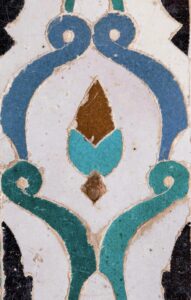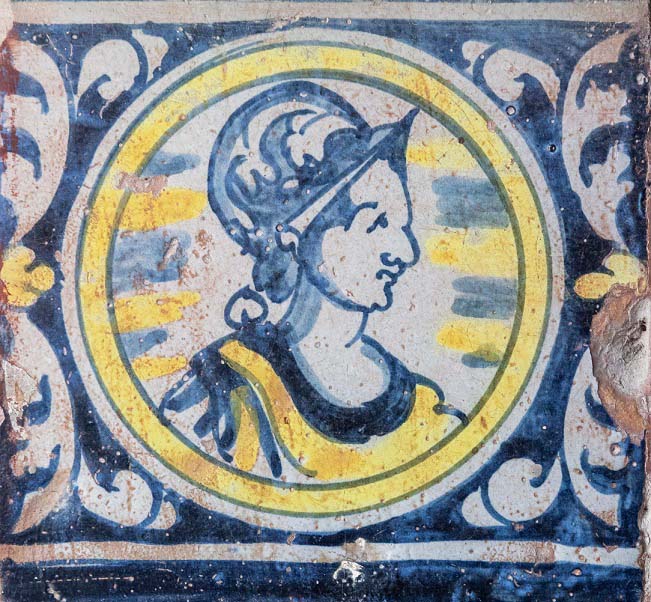Articles
A research recovers the ancient potters women of the Alhambra
Date of publication of the article: 23/02/2023
Year of publication: 2023
Article theme: Al-Andalus, Archaeology, Architecture, Art, History, Women.
Potters women working for the Alhambra, new chronologies or manufacturing methods are some of the numerous contributions of multidisciplinary research, led by the University of Granada, which has been carried out for the first time on the tiled and glazed pieces of the monument.
Research led by the University of Granada has discovered that some emblematic areas of the Alhambra, such as the Patio de Comares or the Palacio de los Leones, had glazed ceramic pieces that embellished these places. Many of these pieces are no longer in their original locations.
The study had also given visibility to the work of the potters of the Alhambra, women who, when they were widowed and had no sons of legal age, were able to continue with the pottery workshop that had previously been run by their husbands. Their work produced unique pieces that embellished the monument.
“The Alhambra was a ceramic city full of colour,” says Elena Díez Jorge, professor of Art History at the UGR and principal investigator of this work. The team led by her has studied thousands of pieces of data on the architectural ceramics of the monumental complex in Granada.
More than five years of study
 The pioneering research in conjunction with the Patronato de la Alhambra y Generalife has taken more than five years to recover more than six thousand pieces of data on the monument’s architectural ceramics, both glazed and unglazed. The analyses have not only taken into account the tiles that cover the architecture but also other pieces such as the glazed skylights that some of the bathrooms had, multi-coloured tiles and even drains made of mud and coloured dressings.
The pioneering research in conjunction with the Patronato de la Alhambra y Generalife has taken more than five years to recover more than six thousand pieces of data on the monument’s architectural ceramics, both glazed and unglazed. The analyses have not only taken into account the tiles that cover the architecture but also other pieces such as the glazed skylights that some of the bathrooms had, multi-coloured tiles and even drains made of mud and coloured dressings.
The exhaustive study of the archival documentation kept in the Alhambra has made it possible to systematize in a database more than four thousand documents with multiple pieces of information, each one of them on new creations, replacements, interventions, and repairs executed over the centuries.
The study had also given visibility to the work of the potters of the Alhambra, women who, when they were widowed and had no sons of legal age, were able to continue with the pottery workshop that had previously been run by their husbands.
This work has managed to “recover what the pieces were called at certain times and how there were spaces that are now bare but were covered with glazed ceramics, such as the walls of the Patio de Comares or part of the pavement of the Palacio de los Leones, to mention two well-known places that we see today with a different image”, explains Elena Díez Jorge, professor at the UGR.
Women potters
Concerning the work of the potters, Díez remarks that these women “ran the workshops very well, some of them successfully, so it is clear that they were familiar with pottery work, although before they were widowed they did not usually appear in payroll books and their names were visible when their husbands died”.
The research has documented several women potters in the 16th and 17th centuries, but also the 19th and 20th centuries. “They made all kinds of pieces, but the ones we have uncovered refer mainly to glazed pieces for the tiling of the Alhambra, that is to say, skirting board coverings, as well as glazed ceramics for flooring (“olambrillas”) and coloured glazed tiles,” explains the professor of Art History.
The research has documented several women potters in the 16th and 17th centuries, but also the 19th and 20th centuries.
The spaces in which these craftswomen worked were pottery houses or potteries. They had a kiln, and several earthenware piles (with unfired clay, another one with clay, another one with coloured clay, and another one with white clay). Nearby there were different loads of wood for the kiln, earthenware moulds, a stone grinder for grinding pigments, and potter’s wheels.
Regarding the work of the potters, Díez points out that these women “ran the workshops very well, some of them successfully, so it is clear that they knew pottery work, although before they were widowed they did not usually appear in payroll books and their names were visible when their husbands died”.
The research has documented several women potters in the 16th and 17th centuries, but also in the 19th and 20th centuries. “They made all kinds of pieces, but the ones we have uncovered refer mainly to glazed pieces for the tiling of the Alhambra, that is to say, skirting board coverings, as well as glazed ceramics for flooring (“olambrillas”) and coloured glazed tiles,” explains the professor of Art History.
The spaces in which these craftswomen worked were pottery houses or potteries. They had a kiln, and several clay piles (with unfired clay, another one “zaleado”, another one with coloured clay, and another one with white clay). Nearby there were different loads of wood for the kiln, clay moulds, a stone grinder for grinding pigments, and potter’s wheels.
A variety of terminologiy
There is a wide range of terminology for the pieces produced. Each has its own name: “cintillas”, “frailes”, “jairas” or “adeferas”, among others. For some of these terms, we have studied how to translate them correctly into English, as this richness is lost in poorly translated publications.
Some of the pieces are imported from Sevillian workshops, such as certain tiles made using the “cuerda seca” technique, and from other parts of the south of Spain. Others are from Granada’s own potteries. Other examples show traces of their manufacture and many of them could even be considered to be pottery waste, which points to high-quality local production.
The archaeometry study reveals that each piece has unique petrographic and compositional characteristics that can help to classify other similar ceramics of uncertain date. In addition, technological particularities have been identified. The samples analysed coincide in showing pieces made with clayey pastes rich in lime and fired in an oxidising atmosphere, regardless of their chronology, obtaining cream-colored biscuits that did not interfere with the glaze. The temperatures used in firing and the pigments and chromophores that give the glazes their color have been identified.
Some of the pieces are imported from Sevillian workshops, such as certain tiles made using the “cuerda seca” technique, and from other parts of the south of Spain.
Documentation reveals that in the 17th century, there was talk of painted tiles for the Hall of the Kings, alluding to the imitation of glazed ceramics that was done with paint. So it is likely that what was done in the 19th century by Rafael Contreras in the Hall of the Kings and other spaces was inspired by this technique of painting that imitated ceramics. Several graffiti or markings have also been documented on some pieces placed in situ in the Alhambra that could allude to some of the documented potters.
More pottery than we see today
Researchers believe that the Alhambra had much more architectural pottery than we see today, some of it treasured in its reserve area, where hundreds of thousands of pieces are preserved, but some of it lost through vandalism or neglect at certain times. Now, with this research, the reality of what the Alhambra was like and what it had is a little closer, “surprising even more if possible because of the beauty that adorned it at different stages of its long history”, concludes Elena Díez.

This multidisciplinary study has involved the work of a variety of researchers from the University of Granada, such as Ignacio Barrea Maturana (Department of Art History), Miguel Busto Zapico (Department of Medieval History and Historiographic Sciences and Techniques), Carolina Cardell Fernández (Department of Mineralogy and Petrology), Alberto García Porras (Department of Medieval History and Historiographic Sciences and Techniques), Isabel Guerra (Centre for Scientific Instrumentation) and Óscar Jiménez Serrano (Department of Translation and Interpretation). Professionals from the University of Zaragoza, the Patronato de la Alhambra y Generalife, and restoration experts have also worked on the study.
Sources:
Translation: FUNCI




